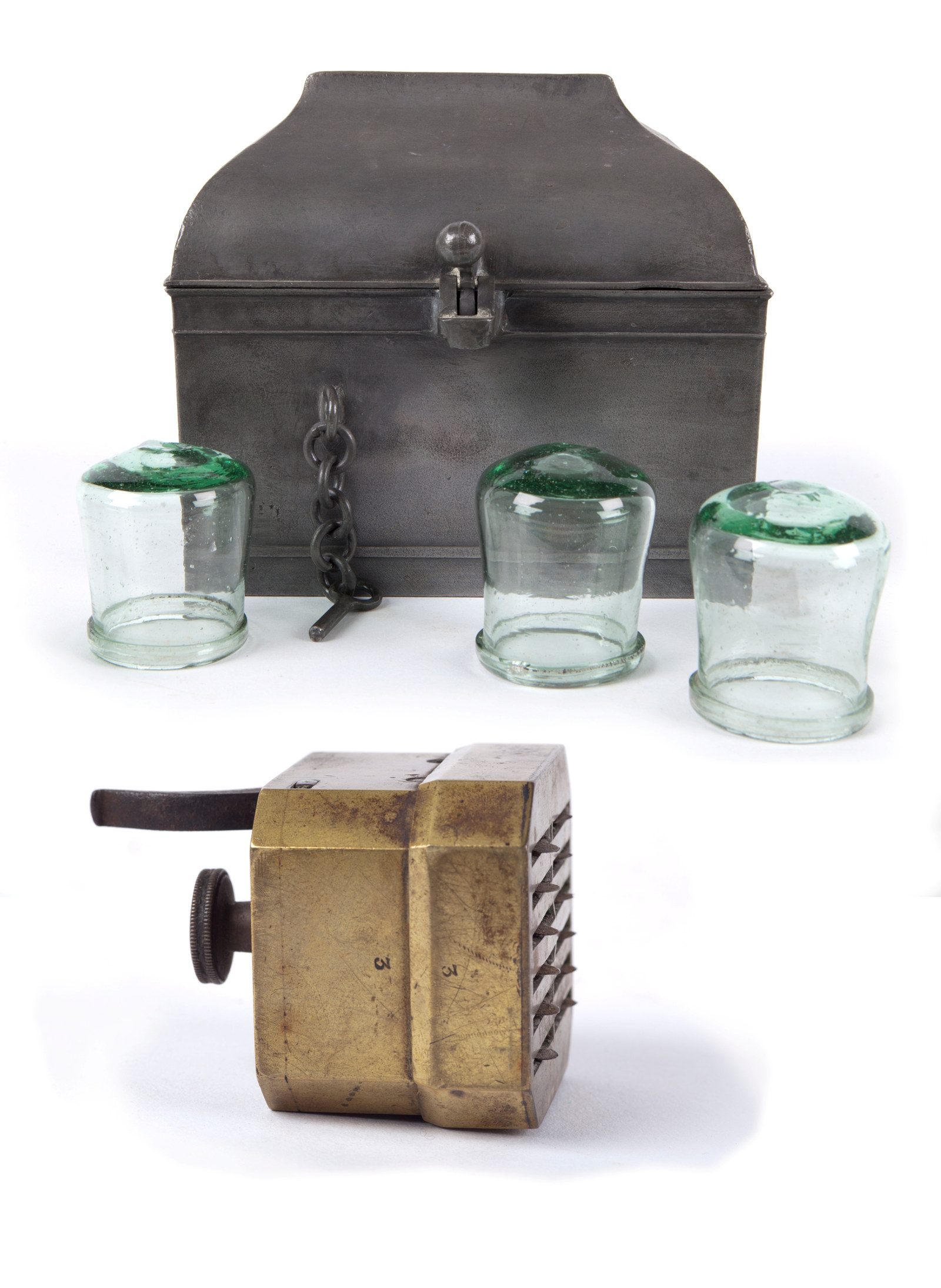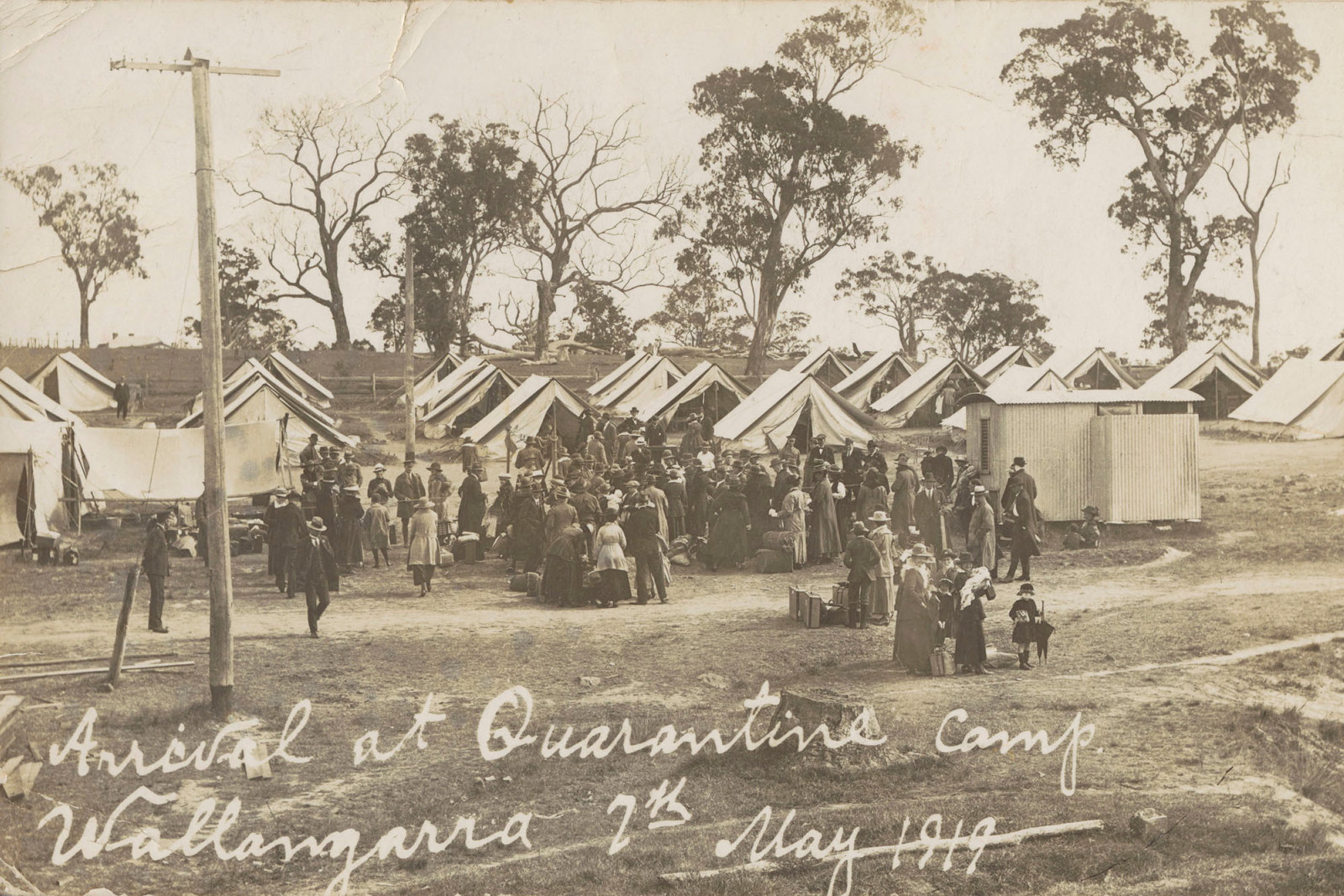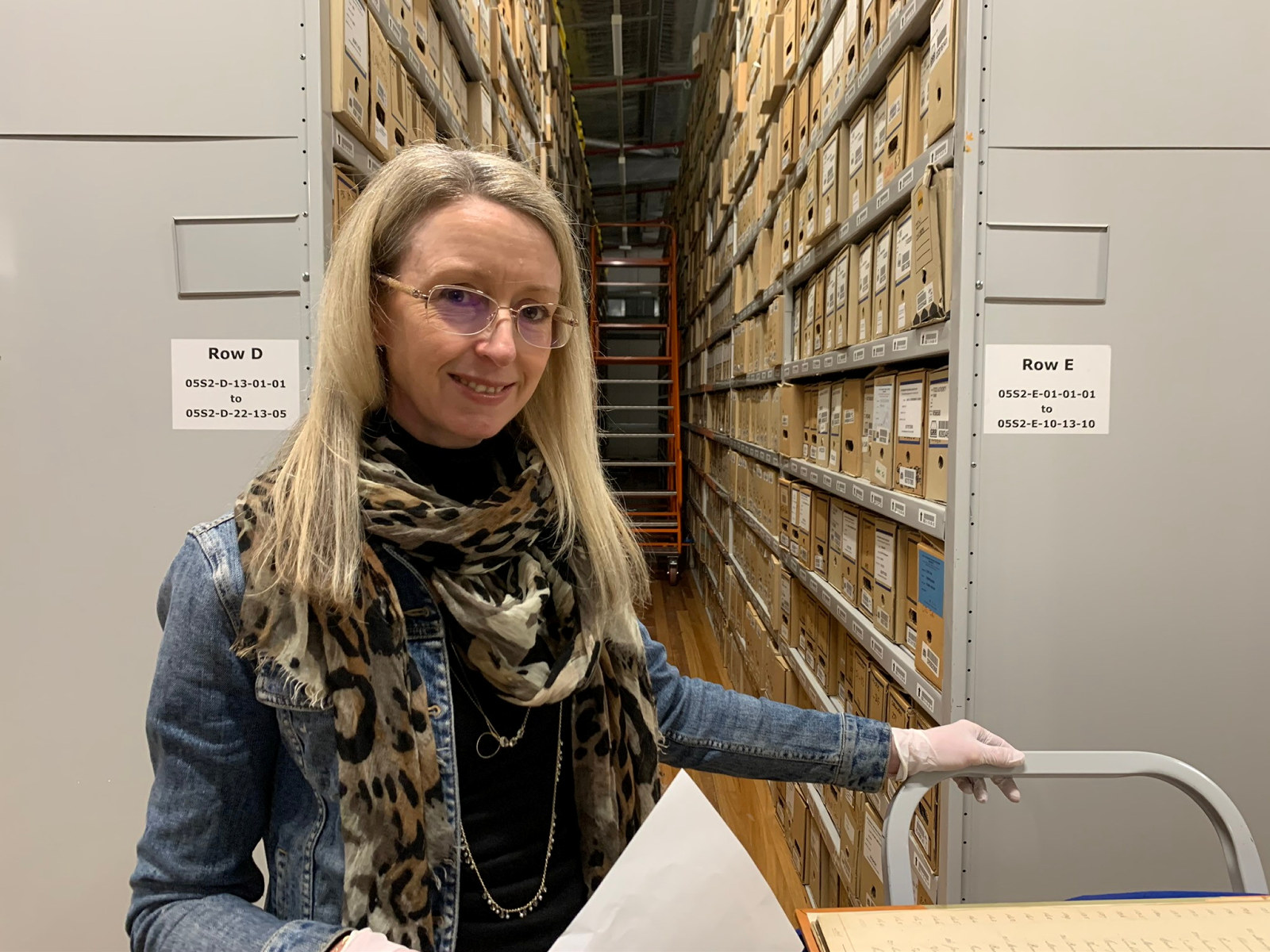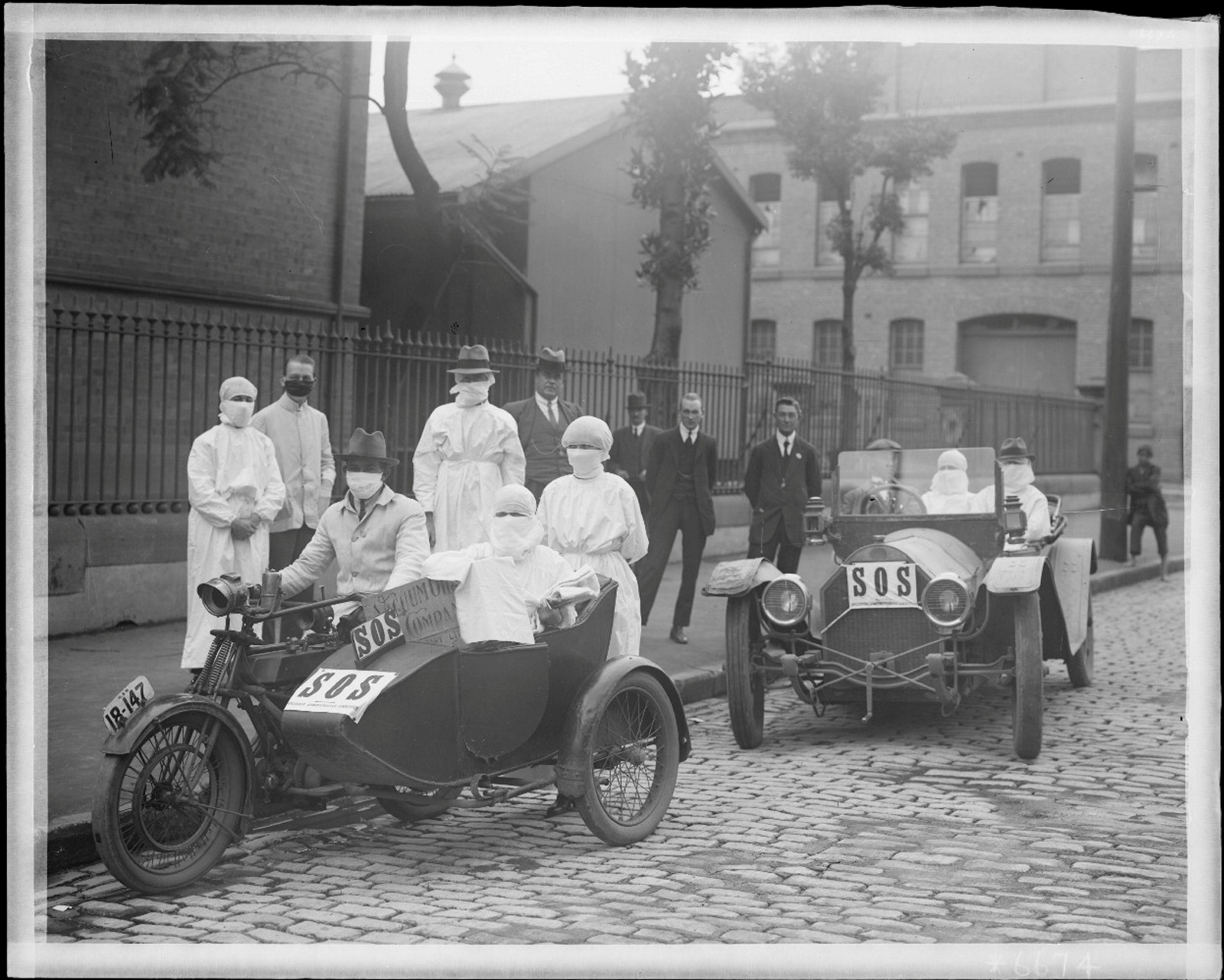Pneumonic influenza (Spanish Flu), 1919
Between January-September 1919, pneumonic influenza, commonly known as the 'Spanish Flu', killed 6,387 people in New South Wales, infecting as many as 290,000 in Metropolitan Sydney alone.1
The pandemic threw the people and Government of the State into a community effort rivalled only by that of the recent war, in an attempt to lessen the spread, and impact, of a deadly disease.
Arrival of the disease
The pneumonic influenza pandemic, which spread throughout the world in 1918-1919, was first reported widely by the media in Spain during mid-1918 when it struck down, but did not kill, that country’s King. Spain was neutral during World War I, and although the disease had reached England and other allied countries at the same time,2 censorship amongst the allies prevented news coverage of the outbreak spreading outside of Spain. Thus, the disease became known as the ‘Spanish Flu’.3
Word reached New South Wales in September 1918, of “devastating outbreaks” of pneumonic influenza in South Africa and America.4 The spread of the disease throughout the world was caused largely by soldiers returning home from active service in Europe. By October, it had hit New Zealand,5 and on 25 October 1918 a ship arrived in Sydney from New Zealand with infected passengers on board. All were safely confined at the North Head quarantine station in Sydney; however, there was a higher than usual death rate from other strains of influenza in NSW during September and October, with 223 mortalities – more than three times the monthly average.6
The New South Wales Government claimed that it was thanks in part to the precautionary measures and planning it had developed (including state-wide free inoculation),7 that the State remained free of pneumonic influenza cases up to the end of 1918.8 By late January 1919, however, at least 326 cases and 49 deaths, had been reported at the quarantine station.9
Then, on 24 January 1919, a “suspicious case of illness” of a soldier at No. 4 Military General Hospital at Randwick, was reported to the NSW Department of Health. The soldier, identified only as ‘S.L.’, had travelled from Melbourne by ship four days before, sharing a compartment with a civilian who was “very ill with aches and pains and a high temperature”.10 S.L. became ill himself on 22 January and was admitted to hospital. Within forty-eight hours three nurses treating him at the hospital also became ill, and during this time, seven other soldiers who had travelled to Sydney from Melbourne were admitted with the same symptoms. The Director-General of Public Health, Dr Robert Thomas Paton, along with other medical experts, visited the patients on 27 January and formally diagnosed the cases as pneumonic influenza.11
Government action
The NSW Government activated two groups it had appointed in November 1918: the Consultative Medical Council (consisting of medical practitioners), and the Metropolitan Citizen’s Influenza Administrative Committee (run from the third floor of the NSW Department of Education building,12 and comprised of politicians, public leaders, and business men and women).13
On advice from the Consultative Medical Council on 28 January, the NSW Government took its first steps in attempting to contain the spread of the disease by issuing the first of many proclamations, beginning with the closure of all “libraries, schools, churches, theatres, public halls, and places of indoor resort for public entertainment”.14
This was followed on 30 January by a trifecta of proclamations: people were required to wear masks covering the mouth and nose; the congregation of people in public spaces was disallowed; and restrictions were placed on crossing from Victoria into NSW.15 The requirements applied firstly to metropolitan Sydney, but soon spread to cover the entire State. The Consultative Medical Council also made a general recommendation that the best “natural resistance” to the disease was fresh air, and therefore encouraged outdoor activity - provided it was conducted away from crowds.16
The Commonwealth Government had called a planning conference on 26-27 November 1918, involving all States, with the aim being “to agree upon a uniform scheme of operations for adoption in the event of an epidemic occurring in any part of Australia.” The conference produced thirteen resolutions, the fourth of which stated that, in the case of a state being proclaimed as infected, all human traffic out of that state was to be suspended.17 After cases reached Sydney by ship, the Victorian Government was accused of having failed to implement this measure. The NSW Government responded by closing the border between the two states in an attempt to stem the flow of infected people into NSW.18
However, this strategy did not succeed. After the initial outbreak in Sydney, the disease spread throughout the State gradually, and from different points, including from near the Victorian border in the towns of Albury and Deniliquin, on 8 February. This was followed by Corowa and Culcairn, then Wagga Wagga, Junee, and Holbrook. West of Sydney it was first reported on 10 February at Penrith, then at Liverpool, Millthorpe, Lithgow, and at Orange. Near the Queensland border it appeared at the same time as it did at Penrith (10 February), followed by Lismore, Murwillumbah, and Kyogle. The last NSW town to report the appearance of the disease was Dorrigo, on 27 September 1919.19
Restrictions continued to be placed on the people of NSW during February 1919, including the added provisions of the closure of racecourses and hotels, and the banning of public meetings.20 Medical practitioners were given powers to restrict the movement of individuals, especially those who had come into contact with infected patients. Fines of £20 or more were applied to those in breach of the new restrictions.21 The impact of the restrictions on employees of many businesses, created the need for relief and support.
The Metropolitan Citizen’s Influenza Administrative Committee established between 80-100 Influenza Relief Depots largely in town halls and public schools across Sydney and its suburbs,22 as community hubs for assisting people who were impacted by the disease. The depots were staffed by a majority (69%) volunteer workforce, as well as nearly 1,200 Metropolitan Sydney public school teachers,23 with nurses and doctors, and fourth-fifth year medical students to relieve the often overworked doctors.24
Depot staff conducted a range of services, from visiting households that displayed a Government-supplied ‘SOS’ sign (indicating the need for assistance)25 to confirming and reporting cases of illness, arranging support for households with multiple cases, removing children from houses where their carers were struck down, and assisting those who were confined to their homes.26 The staff were provided with both volunteered and hired cars, and ninety-five hired motor cycles with side-cars and drivers, to transport nursing and medical staff around Sydney.27 Relief was provided in the form of food, blankets, sheets, towels, clothing,28 rent assistance, and board and lodging, to a total of 79,313 applicants - many of whom had become unemployed as a result of the proclamations.29
The Committee also co-ordinated an influenza-dedicated ambulance service in the Sydney area,30 and organised emergency hospitals in preparation for scenarios in which existing hospital accommodation was inadequate.31 In areas outside of Sydney, similar organisations were formed, such as the Country Influenza Committees which were co-ordinated by the Country Influenza Administrative Board and the Newcastle Influenza Administrative Board.32
Compensation claims
In April 1919 the NSW Government appointed a Committee of Claims to “deal with the various claims made for compensation on account of loss sustained by reason of the closing down of business places, etc., consequent on the influenza epidemic”, or rather, as a result of the restrictions imposed by the Government as a result of the pandemic. The committee was to carry out the intentions laid out in the Proclamation of 27 February that the Government would introduce legislation to “adjust the losses” caused by the pandemic.33
The Influenza Epidemic Relief Act, 1919 (‘epidemic’ being the term used for the outbreak at the time) was assented to on 23 December 1919, and allowed claims for business-related rent, rates and taxes, interest, insurance premiums, wages, living expenses, and lighting charges.34 The Act resulted in a ‘bewildering’ number, and variety, of claims being made, most of which were not covered by the terms of the Act.35 The claimants consisted primarily of private schools, wine and billiard saloons, hotels, picture theatres, and play theatres. In total, out of £214,094, only £30,019 was agreed to be paid. The Commissioner, William James Kessell, noted that the difficulty of the task of determining who should receive what was due to a conflict of interests between the State, and individuals of the State.36
Mortality
In terms of loss of life, the ‘outbreak’ first wave of the disease was “comparatively mild”37 when contrasted with the second and third ‘high-mortality’ waves in 1919. Up until the middle of March 1919, only fifty people had died across NSW,38 while the second wave killed 1,542, and the third 4,302, with the peak occurring between the weeks ending 24 June and 8 July:39
- (Outbreak wave) 27/1/1919 – 18/3/1919
- (High mortality wave) 19/3/1919 – 27/5/1919
- (Highest mortality wave) 28/5/1919 – 30/9/1919
In response to falling mortality rates, most of the restrictions were relaxed in March 1919, but were then reinstated in April as the second wave took hold.40 Also in April, restrictions were placed on people travelling from Sydney to country areas,41 and similarly, people in areas declared to be infected were not allowed to leave them until the disease was declared to have passed.42 In May, again, almost all State-wide restrictions were cancelled,43 and thereafter proclamations were largely town- or region-specific.44
In all there were 6,387 deaths attributed to influenza, pneumonic influenza, and pneumonia,45 of almost 22,000 cases reported in NSW,46 although the actual figure of people infected in Metropolitan Sydney was suggested to be as high as 290,000.47 Densely-populated areas suffered the highest death rates, such as metropolitan Sydney where there were 3,902 deaths (4.3% of the population), which represented 61% of the total deaths in NSW. Mortality rates were highest for people aged 25-39. Males accounted for 3,851 or 60% of all deaths, and of those, 1,522 or nearly 40%, were industrial workers – equal to the combined total deaths of commercial, primary production, and transport and communication workers. In contrast, professional class male workers accounted for only 208 deaths.48 The poor (particularly those living in high-density ‘slum’ areas) and the working class were therefore hardest hit, both in illness and mortality, as well as financially.49
Throughout the world, with no reliable, universal measurement of the impact pneumonic influenza had on many countries, estimations of anywhere between 15 million, and 100 million deaths, have been suggested.50 It is certain, however, that over 12,000 Australians died,51 and that New South Wales accounted for half of that total.
Learnings
The pandemic revealed the poor living conditions many people experienced every day in Sydney.52 Speaking at the Federal Basic Wage Commission in April 1920, Organising Secretary of the Influenza Administrative Committee, William Hilton Mitchell, stated that poor nourishment, and poor living standards contributed directly to the spread of pneumonic influenza. He had found that while the rich could pay for private nurses to care for sick family members, parents and children in poor families were frequently sleeping together in shared beds, with inadequate blankets, and were often left penniless once the household breadwinner became ill.53
The impact of the proclamations, especially prohibiting public meeting, and restricting travel, was seen by some to have been excessive. The Medical Officer of Health for the Hunter District, Dr Robert Dick, voiced that opinion in his report of 1920, noting the measures were largely ineffective in reducing the spread of the pandemic. Only those who were inoculated experienced a less severe attack of the disease, and a lower death rate – yet were still not less likely to contract the disease, he said.54
The event also highlighted the need for reform in medical education and research, medical facilities, as well as national co-ordination. The difficulty of a consistent approach between city and country areas is demonstrated in Dr Dick’s report, in which he recommends that the Hunter region in future adopt a range of measures that were, in fact, implemented in Sydney during the outbreak.55 The medical profession as a whole, learned much about the importance of public health - in particular the gaps that existed in public health services that had to be covered to deal with the crisis of 1919, and which would contribute towards reform in coming decades.56
Key records identified
Colonial/Chief Secretary
- NRS 905 Main series of letters received [various - see footnotes]
- NRS 906 Special bundles:[5/5242] Pneumonic Influenza Claims Committee; [5/5348.1] Pneumonic Influenza - Claims Committee
- NRS 1118 Distress Relief Fund, Pneumonic Influenza: Food order and invoice book (lists date received, name of claimant, name of recipient, depot of issue, and amount received): [5/1203]
Department of Education
- NRS 3830 Subject files: [20/12717] Government Correspondence
Premier's Department
- NRS 12060 Letters received [various - see footnotes]
- NRS 12061 Special bundles: [4/6247] Influenza Papers, 1918-1919
Government Printing Office
- NRS 4481 Glass negatives [various - see images above for citations]
Department of Health
- NRS 4838 Salary registers (lists staff including nurses and doctors engaged in influenza activities): [3/5622], folios 161-199; [3/5623], folios 191-195 (part)
Footnotes
[1] New South Wales Parliament: Joint Volumes of Papers Presented to the Legislative Council and Legislative Assembly (Parliamentary Papers), 1920, Volume 1, ‘Outbreak of Pneumonic Influenza in New South Wales in 1919’, Section V, Part I, p. 153
[2] Parliamentary Papers, 1920, Volume 1, ‘Outbreak of Pneumonic Influenza in New South Wales in 1919’, Section V, Part I, p. 148
[3] Mamelund, S. (2017). Profiling a Pandemic: Who were the Victims of the Spanish Flu? Natural History, 2017, Vol.125(7), p.6(4), p. 6
[4] Parliamentary Papers, 1919, Volume 3, ‘Report of the Director-General of Public Health New South Wales, 1918’, p. 4
[5] Parliamentary Papers, 1919, Volume 3, ‘Report of the Director-General of Public Health New South Wales, 1918’, p. 4; Parliamentary Papers, 1920, Volume 1, ‘Outbreak of Pneumonic Influenza in New South Wales in 1919’, Section V, Part I, p. 148
[6] New South Wales Government, Smith, H. (1921). The Official Year Book of New South Wales 1920, p. 104
[7] Parliamentary Papers, 1920, Volume 1, ‘Outbreak of Pneumonic Influenza in New South Wales in 1919’, Section V, Part I, p. 154
[8] Parliamentary Papers, 1919, Volume 3, ‘Report of the Director-General of Public Health New South Wales, 1918’, p. 4
[9] Parliamentary Papers, 1920, Volume 1, ‘Outbreak of Pneumonic Influenza in New South Wales in 1919’, Section V, Part I, p. 148
[10] Parliamentary Papers, 1920, Volume 1, ‘Outbreak of Pneumonic Influenza in New South Wales in 1919’, Section V, Part I, p. 149
[11] Parliamentary Papers, 1920, Volume 1, ‘Outbreak of Pneumonic Influenza in New South Wales in 1919’, Section V, Part I, p. 149
[12] New South Wales State Archives (NSWSA): Department of Education; NRS 3830 Subject Files, 1875-1948, [20/12717] Government Correspondence, 19/61831 (letterhead)
[13] Parliamentary Papers, 1920, Volume 1, ‘Outbreak of Pneumonic Influenza in New South Wales in 1919: Report of the Metropolitan Citizens’ Administrative Committee’, Section I, Introductory, p. 3
[14] Government Gazette of the State of New South Wales, 1919, No. 13, 28/1/1919
[15] Government Gazette of the State of New South Wales, 1919, No. 14, 30/1/1919
[16] New South Wales State Archives: Premier’s Department; NRS 12060 Letters received, [9/4814], B19/1814, ‘Notes of Cabinet Meeting held at the Treasury on Saturday, 1st February, 1919, in regard to the Pneumonic-Influenza Epidemic’, p. 2
[17] Parliamentary Papers, 1920, Volume 1, ‘Outbreak of Pneumonic Influenza in New South Wales in 1919’, Section V, Part I, p. 158
[18] Arrowsmith, R. (2007). A Danger Greater Than War: NSW and the 1918-1919 Influenza Pandemic. Curtin : Homeland Security Communications Groups, pp. 7-8
[19] Parliamentary Papers, 1920, Volume 1, ‘Outbreak of Pneumonic Influenza in New South Wales in 1919’, Section V, Part I, pp. 166-167
[20] New South Wales State Archives: Chief Secretary; NRS 906 Special Bundles, Pneumonic Influenza – Claims Committee [5/5348.1], ‘Influenza Gazettes’, p. 1
21] Government Gazette of the State of New South Wales, 1919, No. 34, 13/2/1919
[22] Parliamentary Papers, 1920, Volume 1, ‘Outbreak of Pneumonic Influenza in New South Wales in 1919: Report of the Metropolitan Citizens’ Administrative Committee’, Section IV, Home Nursing, p. 10, point 46; NSWSA: Chief Secretary; NRS 905 Main series letters received, [5/5097], 19/57570
[23] Parliamentary Papers, 1920, Volume 1, ‘Outbreak of Pneumonic Influenza in New South Wales in 1919: Report of the Metropolitan Citizens’ Administrative Committee’, Section VIII, Conclusion, pp. 17-22; NSWSA: Department of Education; NRS 3830 Subject Files, 1875-1948, [20/12717] Government Correspondence, 19/61831, ‘Teachers who have volunteered for Relief Work’
[24] Parliamentary Papers, 1920, Volume 1, ‘Outbreak of Pneumonic Influenza in New South Wales in 1919: Report of the Metropolitan Citizens’ Administrative Committee’, Section IV, Home Nursing, p. 12
[25] Parliamentary Papers, 1920, Volume 1, ‘Outbreak of Pneumonic Influenza in New South Wales in 1919: Report of the Metropolitan Citizens’ Administrative Committee’, Section IV, Home Nursing, p. 11, point 53
[26] Parliamentary Papers, 1920, Volume 1, ‘Outbreak of Pneumonic Influenza in New South Wales in 1919’, Section V, Part I, p. 160
[27] Parliamentary Papers, 1920, Volume 1, ‘Outbreak of Pneumonic Influenza in New South Wales in 1919: Report of the Metropolitan Citizens’ Administrative Committee’, Section IV, Home Nursing, pp. 11-12
[28] ‘Homes of the Poor’. The Sun, 29/6/1919, p. 7
[29] Parliamentary Papers, 1920, Volume 1, ‘Outbreak of Pneumonic Influenza in New South Wales in 1919: Report of the Metropolitan Citizens’ Administrative Committee’, Section VI, Relief of Distress, pp. 14
[30] Parliamentary Papers, 1920, Volume 1, ‘Outbreak of Pneumonic Influenza in New South Wales in 1919: Report of the Metropolitan Citizens’ Administrative Committee’, Section II, Ambulance Organisation, p. 5
[31] Parliamentary Papers, 1920, Volume 1, ‘Outbreak of Pneumonic Influenza in New South Wales in 1919: Report of the Metropolitan Citizens’ Administrative Committee’, Section III, Emergency Influenza Hospitals, p. 10
[32] Parliamentary Papers, 1920, Volume 1, ‘Outbreak of Pneumonic Influenza in New South Wales in 1919: Report of the Metropolitan Citizens’ Administrative Committee’, Section I, Introductory, p. 4
[33] NSWSA: NRS 906, [5/5242] Pneumonic Influenza Claims Committee, ‘Memorandum: Closing of Businesses, etc., owing to operation of Government Proclamation’, 30/4/1919; Government Gazette of the State of New South Wales, 1919, No. 44, 27/2/1919
[34] Parliamentary Papers, Second Session 1920, Volume 3, ‘Progress Report of Royal Commission of Inquiry (Mr W J Kessell) into Claims Lodged Under the Provisions of the Influenza Epidemic Relief Act, 1919, Together with Schedules’, p. 4
[35] Parliamentary Papers, Second Session 1920, Volume 3, ‘Progress Report of Royal Commission of Inquiry (Mr W J Kessell) into Claims Lodged Under the Provisions of the Influenza Epidemic Relief Act, 1919, Together with Schedules’, p. 4
[36] Parliamentary Papers, Second Session 1920, Volume 3, ‘Final Report of Royal Commission of Inquiry (Mr W J Kessell) into Claims Lodged Under the Provisions of the Influenza Epidemic Relief Act, 1919, Together with Schedules’, p. 3
[37] Parliamentary Papers, 1920, Volume 1, ‘Outbreak of Pneumonic Influenza in New South Wales in 1919: Report of the Metropolitan Citizens’ Administrative Committee’, Section I, Introductory, p. 3
[38] Parliamentary Papers, 1920, Volume 1, ‘Outbreak of Pneumonic Influenza in New South Wales in 1919’, Section V, Part II, p. 174
[39] Parliamentary Papers, 1920, Volume 1, ‘Outbreak of Pneumonic Influenza in New South Wales in 1919’, Section V, Part II, p. 174
[40] Parliamentary Papers, 1920, Volume 1, ‘Outbreak of Pneumonic Influenza in New South Wales in 1919’, Section V, Part I, p. 159
[41] Parliamentary Papers, 1920, Volume 1, ‘Outbreak of Pneumonic Influenza in New South Wales in 1919’, Section V, Part I, p. 160
[42] NSWSA: NRS 12060, [9/4814], B19/1867 [copies of influenza-related NSW Government Gazettes]
[43] Government Gazette of the State of New South Wales, 1919, No. 111, 15/5/1919
[44] NSWSA: NRS 12060, [9/4814], B19/1867 [copies of influenza-related NSW Government Gazettes]
[45] New South Wales Government, Smith, H. (1921). The Official Year Book of New South Wales 1920, p. 106
[46] NSWSA: Chief Secretary; NRS 905 Main series letters received, [5/5098], 19/58068
[47] Parliamentary Papers, 1920, Volume 1, ‘Outbreak of Pneumonic Influenza in New South Wales in 1919’, Section V, Part I, pp. 152-153
[48] New South Wales Government, Smith, H. (1921). The Official Year Book of New South Wales 1920, p. 114
[49] Arrowsmith, R. (2007). A Danger Greater Than War: NSW and the 1918-1919 Influenza Pandemic. Curtin : Homeland Security Communications Groups, p. 74
[50] [15-25 million]: Arrowsmith, R. (2007). A Danger Greater Than War: NSW and the 1918-1919 Influenza Pandemic. Curtin : Homeland Security Communications Groups, p. 2; [40 million]: World Health Organization (Global Alert and Response). (2019). WHO Report on Global Surveillance of Epidemic-prone Infectious Diseases – Influenza, ‘Background of the Disease’. Retrieved from: Website ... [50-100 million]: Mamelund, S. (2017). Profiling a Pandemic: Who were the Victims of the Spanish Flu? Natural History, 2017, Vol.125(7), p.6(4), p. 6
[51] Arrowsmith, R. (2007). A Danger Greater Than War: NSW and the 1918-1919 Influenza Pandemic. Curtin : Homeland Security Communications Groups, p. viii
[52] Arrowsmith, R. (2007). A Danger Greater Than War: NSW and the 1918-1919 Influenza Pandemic. Curtin : Homeland Security Communications Groups, pp. 73-75
[53] ‘Living Conditions’. Sydney Morning Herald, 30/04/1920, p. 9. Retrieved from NLA website
[54] Parliamentary Papers, 1920, Volume 1, ‘Outbreak of Pneumonic Influenza in New South Wales in 1919’, Section V, Part I, ‘Influenza Epidemic in the Hunter River Combined Districts’, pp. 171-172
[55] Parliamentary Papers, 1920, Volume 1, ‘Outbreak of Pneumonic Influenza in New South Wales in 1919’, Section V, Part I, ‘Influenza Epidemic in the Hunter River Combined Districts’, p. 172
[56] Arrowsmith, R. (2007). A Danger Greater Than War: NSW and the 1918-1919 Influenza Pandemic. Curtin : Homeland Security Communications Groups, pp. 73, 75
Published on
Related stories
Browse all
Convict Sydney
Cupping glasses & scarificator
These cupping glasses are of the type that was used in the treatment of convict patients at the General ‘Rum’ Hospital

When masks were compulsory
When thinking about the impact of COVID-19, it’s timely to reflect on an earlier pandemic that affected every aspect of life, including at our places

Archives behind the scenes - bubonic plague
Did you know there was an outbreak of plague, in Sydney, at The Rocks, in 1900?

On This Day
27 Jan 1919 - Influenza pandemic reached NSW
On 27 January 1919, the NSW Government announced the first confirmed case of pneumonic influenza, the 'Spanish Flu', in NSW